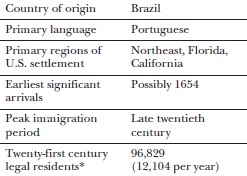Brazilian immigrants
2011-08-16 09:32:28
Significance: Economic and political instability in Brazil during the late twentieth century prompted unprecedented emigration fromthe country. Approximately one million Brazilians came to live in the United States. Many of these immigrants took jobs in service industries in northeastern metropolitan areas, southern Florida, and California. Mostly members of the middle and upper classes in their native country, they came primarily from the Europeanized southern areas of Brazil.
The first Brazilians to enter what is now the United States may have been a group of Sephardic Jews who arrived in 1654. Calculating the number of Brazilians in the United States is speculative.With a sparse migration history, they have been ambiguously identified by immigration agencies as “Hispanic,” “Latino,” and “South” or “Latin” American. The U.S. Census Bureau first listed a category for Brazilians residents in 1960, calculating under thirty thousand. Until the 1980’s, no more than a few thousand entered annually.
Profile of Brazilian immigrants
 Immigrants who obtained legal permanent resident status in the United States.
Source: Department of Homeland Security, Yearbook of Immigration Statistics, 2008.
Immigrants who obtained legal permanent resident status in the United States.
Source: Department of Homeland Security, Yearbook of Immigration Statistics, 2008.
The 1980’s saw a gargantuan swell of immigrants seeking economic opportunity and fleeing social decay. During that decade, Brazil suffered hyperinflation that paralyzed its economy, causing unemployment to soar. Moreover, an authoritarian military government was replaced by a democratic civilian administration. These factors prompted numerous middle- and upper-class Brazilians to emigrate, primarily to Europe and the United States. By the end of the twentieth century, approximately two million Brazilians had migrated abroad, more than 1 percent of the national population.
Brazil is a country of richly mixed African, European, and indigenous ethnicities. However, the Brazilians most likely to emigrate were from the European-heritage southern parts of the country. They settled in northeastern U.S. states with Portuguese-speaking communities, East Coast metropolitan areas with varied job opportunities, and in parts of California and southern Florida with climates similar to those of their homeland. California and Florida tended to attract upper-class Brazilians with professional and artistic ambitions. About 100,000 Brazilians lived in New York City, forming a Little Brazil neighborhood in mid-Manhattan, where the monthly tabloid newspaper The Brasilians was launched.
Immigration from Brazil, 1920-2008
 Source: Department of Homeland Security, Yearbook of Immigration Statistics, 2008. Figures include only immigrants who obtained legal permanent resident status.
Source: Department of Homeland Security, Yearbook of Immigration Statistics, 2008. Figures include only immigrants who obtained legal permanent resident status.
At the beginning of the twenty-first century, approximately one million Brazilians lived in the United States. However, that figure is merely an estimate because as many as one-third of the Brazilian immigrants enter the United States without documentation to evade quota restrictions. One city in central Brazil became notorious for sending clandestine immigrants, who settle mostly in New Jersey and work shoeshine services.
Middle-class Brazilians who have settled in the United States may decline in social status, working in restaurants and housecleaning jobs; but they improve economically relative to Brazil, sending back remittances to their families. Economic and political conditions have greatly improved in Brazil during the twentyfirst century so that the impetus for immigrating has declined. At the same time, since the terrorist attacks on September 11, 2001, U.S. immigration and police agents are more vigilant regarding illegal immigrants. Thereby, uncertain legal status and marginal socioeconomic status has prompted many Brazilians to return to Brazil.
Edward A. Riedinger
Further Reading
- Beserra, Bernadete. Brazilian Immigrants in the United States: Cultural Imperialism and Social Class. New York: LFB Scholarly Publishing, 2003.
- Jouët-Pastré, Clémence, and Leticia J. Braga. Becoming Brazuca: Brazilian Immigration to the United States. Cambridge, Mass.: David Rockefeller Center for Latin American Studies, Harvard University Press, 2008.
- Margolis, Maxine L. Little Brazil: An Ethnography of Brazilian Immigrants in New York City. Princeton, N.J.: Princeton University Press, 1994.
See also: California; Economic consequences of immigration; Economic opportunities; Employment; Florida; Latin American immigrants; New Jersey; New York City; Portuguese immigrants; Push-pull factors; Remittances of earnings.
- People
- Immigrant groups
- Labor
- Nativism
- Civil rights and liberties
- Cities
- Culture
- Refugees and displaced persons
- Court cases
- Illegal immigration
- Advocacy organizations and movements
- Health
- Arts and music
- European immigrants
- Anti-immigrant movements and policies
- African immigrants
- Citizenship and naturalization
- States
- Asian immigrants
- Agricultural workers
- Children
- Immigration reform
- Laws
- East asian immigrants
- Borders
- Deportation
- Events and movements
- International agreements
- Mexican immigrants
- Education
- Emigration
- Theories
- Ethnic enclaves
- Latin american immigrants
- Business
- Science and technology
- Government agencies and commissions
- Politics and government
- Family issues
- Women
- Economic issues
- Southeast asian immigrants
- Canadian immigrants
- Push-pull factors
- Transportation
- Slavery
- Philanthropy
- Religion
- Demographics
- Research
- Assimilation
- Literature
- Subversive and radical political movements
- Communications
- Journalism
- Language issues
- Crime
- Violence
- Military
- Wars
- Law enforcement
- West indian immigrants
- Stereotypes
- Symbols
- Land
- Psychology
- South and Southwest Asian immigrants
- Pacific Islander immigrants
- Colonies and colonial regions
- Legislation and regulations
- Canada
- United States
- War and immigration
- Administration
- Hispanic issues and leaders
- Treaties
- Economics and commerce
- Immigration policy
- Religion
- Colonial founders and leaders
- Explorers and geographers
- France
- Political figures: Canada
- Political figures: United States
- Race and ethnicity
- Reformers, activists, and ethnic leaders
- Women